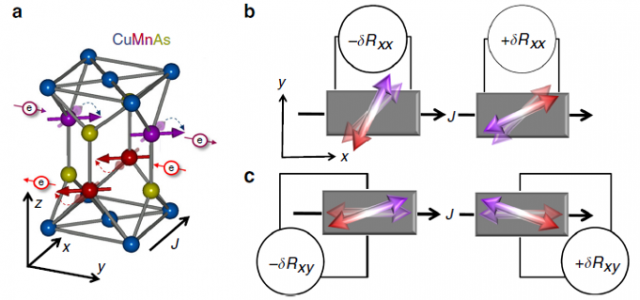Detection of the reversal of magnetic moments in an antiferromagnet

Some metals, alloys and transition-element salts exhibit a form of magnetism called antiferromagnetism. This occurs below a certain temperature, named after Louis Néel, when an ordered array of atomic magnetic moments spontaneously forms in which alternate moments have opposite directions. There is therefore no net resultant magnetic moment in the absence of an applied field.
In manganese fluoride, for example, this antiparallel arrangement occurs below a Néel temperature of 72 K. Below this temperature the spontaneous ordering opposes the normal tendency of the magnetic moments to align with the applied field. Above the Néel temperature de substance is paramagnetic, i.e., it has a net spin magnetic moment that is capable of being aligned in the direction of the applied field.
Within the emerging field of spin-based electronics, or spintronics, information is typically defined by the orientation of the magnetization of ferromagnets. Recently, antiferromagnets are also being investigated for this purpose. Here the information is encoded in the direction of the magnetic moments, the so-called Néel vector. In principle, antiferromagnets are much faster encoding information and, as we have seen, are very stable with respect to disturbing external fields. These advantages, however, also imply a challenging manipulation and read-out processes of the Néel vector orientation. A substance where this had been possible is copper manganese arsenide, CuMnAs, which comprises two collinear spin sublattices and belongs to an antiferromagnetic symmetry group with no net magnetic moment.
But the point is, if in an antiferromagnet the information is encoded in the direction of the magnetic moments, how can we detect a change in that direction? In other words, how can we see a 180º reversal of the Néel vector?
The electrical detection of the 180° spin reversal, which is the basis of the operation of ferromagnetic memories, has been among the outstanding challenges in the research of antiferromagnetic spintronics. This is because analogous effects to the ferromagnetic ones have not yet been realized in antiferromagnetic multilayers.

Now, a team of researchers, including Rubén M. Otxoa (DIPC & Hitachi Cambridge Laboratory) demonstrate 1 the electrical detection of the 180° Néel vector reversal in CuMnAs. They achieve this by measuring a second-order magnetotransport coefficient whose presence is allowed in systems with broken space inversion symmetry.
The phenomenology of the non-linear transport effect the researchers observe in CuMnAs is consistent with a microscopic scenario combining anisotropic magnetoresistance with a transient tilt of the Néel vector due to a current-induced, staggered spin-orbit field. They use the same staggered spin-orbit field, but of a higher amplitude, for the electrical switching between reversed antiferromagnetic states, which are stable and show no sign of decay over 25 h probing times.
Most importantly, this method is not restricted to CuMnAs. CuMnAs is one example from the 59 antiferromagnetic point groups with broken time reversal symmetry that has also broken space inversion symmetry in the magnetic crystal. In general, 48 out of the 59 antiferromagnetic point groups and 21 out of the 31 ferromagnetic point groups have broken space inversion symmetry, which makes the second-order detection method of the 180° spin reversal broadly applicable in antiferromagnets.
Author: César Tomé López is a science writer and the editor of Mapping Ignorance
References
- J. Godinho, H. Reichlová, D. Kriegner, V. Novák, K. Olejník, Z. Kašpar, Z. Šobáň, P. Wadley, R. P. Campion, R. M. Otxoa, P. E. Roy, J. Železný, T. Jungwirth & J. Wunderlich (2018) Electrically induced and detected Néel vector reversal in a collinear antiferromagnet Nature Communications doi: 10.1038/s41467-018-07092-2 ↩